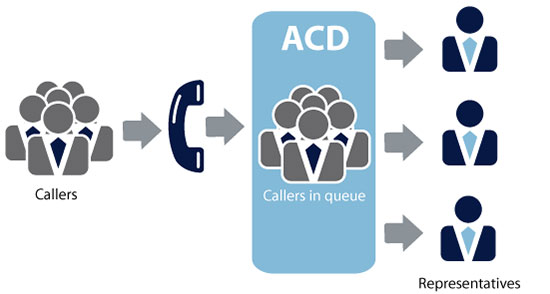What Is an ACD System?

Call centers have experienced a time of transition in recent years, as jobs flow back into the country from overseas. As consumers have become pickier about their customer service or buying experiences, so too has hiring and training among CSR ranks become more selective.
If you’re involved in the business, it’s important to stay on top of modern call center technology, and that includes tech like automatic call distribution. Read on for more details.
Automatic call distribution
Automatic call distribution (ACD) is a fantastic tool that call centers use to combat the negative energy felt by many call center reps. ACD systems, simply put, route calls to the best available representative in order to maximize customer satisfaction. This is critically important for keeping repeat business and for building new relationships with leads that representatives hope to develop into loyal customers.
These systems utilize a number of techniques to organize both reps and clients in order to pair callers with the best possible outcome and, in the process, maintain a great relationship even through what is often a call originating in frustration or anger.
The newest of these techniques can route calls to a repeat agent who is familiar with a particular client’s needs, direct a client to a representative with specific language assets, or funnel a call toward an agent with subject area expertise in their specific concern. This process transforms the customer’s experience with a historically drab interaction into something that can even be pleasant.
Modern call center challenges
Only a decade ago, the trend of outsourcing calling staff began to reverse itself and has picked up steam ever since. 2019 has seen its fair share of news contributors discussing this influx. The trend is only growing: today, more than 250,000 callers reside in Texas alone. Compared to the roughly 700,000 jobs in the entirety of the Philippines — once a juggernaut of phone centers — we can see this corporate shift in vivid detail.
However, along with returning jobs and high wages for top talents in American cities comes another task: finding that talent that will grow your bottom line in a market saturated with competition and fighting for space in a variety of ways. Robocalling is at an all-time high, with 16 billion of them burning up American phone lines last year alone.
This equates to eroding trust in the ringing of a phone in the homes of tens of millions of Americans: think of that cliché movie scene where our heroic protagonist hangs up a tense phone call and then the line rings again and she ends up answering an important call with hostility, expecting that previous voice to answer her back.
Considering the number of scammers active around the world and the inundating volume of recordings that disturb our line, it is no wonder why Americans are by and large hesitant to pick up the phone at all. ACDs go a long way toward alleviating these negative associations.
What else can ACDs do?
ACD systems are also applicable to contact forms outside of the traditional calling setting. If your office employs texting or online chat forums for client access, ACD can streamline these processes as well.
This is done through the implementation of a cutting edge IVR (“interactive voice response”) system to work in parallel with the routing function. IVR systems are those recorded messages that ask you to punch in a number relating to your inquiry, and are overwhelmingly despised by American consumers. ACD functionality requires some input however, and the user experience here is a priority among creators in this space.
Call centers have known for more than a decade now that client satisfaction runs parallel to profit, and have taken steps to maximize the customer experience while on the phone with an agent. ACD is the future of these measures to enhance both profitability and client satisfaction at the same time.
